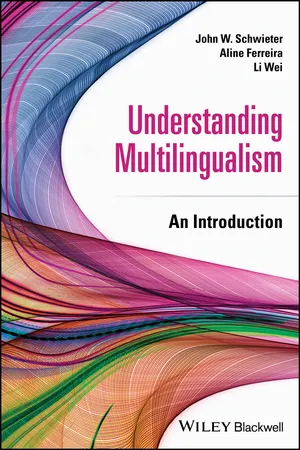
- 243 pages
- English
- PDF
- Available on iOS & Android
About this book
Including detailed discussions of both the current state and future directions of the field, this comprehensive textbook presents a complete overview of multilingualism.
Written by internationally recognized researchers and educators, Understanding Multilingualism: An Introduction provides detailed coverage of the various dimensions of modern multilingualism. It highlights the interdisciplinary nature of the field by exploring the broad spectrum of different sociolinguistic, psycholinguistic, and neurocognitive approaches to the study of multilingualism.
The text begins by defining and clarifying the scope of multilingualism studies as a distinctive, interdisciplinary field of inquiry. Subsequent chapters discuss the historical development and theoretical models of multilingualism, how the brain processes multiple languages, the effect of multilingualism on human cognition, how multilingual processing changes over the human lifespan, societal management of multilingualism, multilingual education, and impact of technological advancement on multilingualism. The book concludes by addressing the prospect of a post-multilingual world and methodological issues in studying multilingualism.
- Considers the cognitive and linguistic implications of multilingualism to applied linguistics and language acquisition
- Examines the connections between multilingualism and changing socio-political and economic landscapes
- Reviews modern theories, methods, and research findings in multilingualism studies
- Discusses complex topics at both the individual and societal level
- Features numerous exercises, discussion questions, assignments, further readings, suggested research topics, and real-life case studies
Understanding Multilingualism: An Introduction is the perfect primary textbook for undergraduate courses in multilingualism and bilingualism, and an excellent resource for advanced students in applied linguistics, sociolinguistics, psycholinguistics, second language acquisition, and foreign language education programs.
Frequently asked questions
- Essential is ideal for learners and professionals who enjoy exploring a wide range of subjects. Access the Essential Library with 800,000+ trusted titles and best-sellers across business, personal growth, and the humanities. Includes unlimited reading time and Standard Read Aloud voice.
- Complete: Perfect for advanced learners and researchers needing full, unrestricted access. Unlock 1.4M+ books across hundreds of subjects, including academic and specialized titles. The Complete Plan also includes advanced features like Premium Read Aloud and Research Assistant.
Please note we cannot support devices running on iOS 13 and Android 7 or earlier. Learn more about using the app.
Information
Table of contents
- Cover
- Title Page
- Copyright Page
- Contents
- About the Authors
- Preface
- Acknowledgments
- Chapter 1 Defining Multilingualism
- Chapter 2 Learning More than One Language
- Chapter 3 Psycholinguistic Models of Multilingualism
- Chapter 4 The Multilingual Brain
- Chapter 5 Cognitive Effects of Multilingualism
- Chapter 6 Multilingualism Across the Lifespan
- Chapter 7 Language Attrition and Maintenance
- Chapter 8 Multilingual Communities and Families in Society
- Chapter 9 Multilingualism in Education
- Chapter 10 Digital Technology, Media, and Multilingualism
- Chapter 11 Beyond Multilingualism: Rethinking Practice, Policy, and Theory from a Translingual Perspective
- Chapter 12 Designing and Conducting Research in Multilingualism
- Glossary
- Index
- EULA